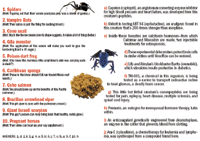Let's Play Pharmazooticals
Pharmaceutical Executive
When it comes to developing novel therapies from the animal kingdom, it's mostly a game of pick your poison
Thanks to the press coverage—and the graphic photos—of the heparin contamination story (see "Chinese Puzzle"), which took readers into the tiny rural workshops where raw pig intestines are both pulped for crude heparin and stripped for sausage casings, some of us have crossed pork off our menus. But deriving a lifesaving therapy from hog guts got us wondering what other modern meds come from our animal friends.

The answer, it seems, is more every day. Cows started the trend back in 1921, by offering up their pancreas to Canadian surgeon Frederick Banting for his discovery of insulin to lower blood sugar in diabetics. Banting got a Nobel Prize while Bessie got the glue factory.
Since then, researchers wishing to get out of the lab to design new drugs have generally had to bypass the local farm for more adventurous settings. That's because the best pickings in promising proteins, hormones, and molecules tend to reside not in fish, fowl, or beast but in the creepy crawlers, like tarantulas and lizards. Snakes—ugh—are very big on Mother Nature's drug development list, venom being a treasure-trove of potential medical applications. That explains why a German biotech has a high-security facility housing 30,000 vipers.
So how do scientists figure out which viper has the goods? Trial and terror?
Not so much. It seems to call for inspired inductive leaps. For example, Dr. Michael Zasloff, biomedical researcher, entrepreneur, and holder of more than 40 patents, was pondering one day why frogs can hang out in filthy water holes without getting sick. Well, their skin contains a potent antimicrobial peptide that is now called Magainin 2 and sold for research into resistance-resistant antibiotics.
Get it? Good. So now let's play Pharmazooticals. Match the creature on the left with the potential medical application on the right. –WALTER ARMSTRONG AND SARAH WHARTON

Addressing Disparities in Psoriasis Trials: Takeda's Strategies for Inclusivity in Clinical Research
April 14th 2025LaShell Robinson, Head of Global Feasibility and Trial Equity at Takeda, speaks about the company's strategies to engage patients in underrepresented populations in its phase III psoriasis trials.
Beyond the Prescription: Pharma's Role in Digital Health Conversations
April 1st 2025Join us for an insightful conversation with Jennifer Harakal, Head of Regulatory Affairs at Canopy Life Sciences, as we unpack the evolving intersection of social media and healthcare decisions. Discover how pharmaceutical companies can navigate regulatory challenges while meaningfully engaging with consumers in digital spaces. Jennifer shares expert strategies for responsible marketing, working with influencers, and creating educational content that bridges the gap between patients and healthcare providers. A must-listen for pharma marketers looking to build trust and compliance in today's social media landscape.
Pfizer, GSK Gain ACIP Recommendations for RSV and Meningococcal Vaccines
April 18th 2025The Centers for Disease Control and Prevention’s Advisory Committee on Immunization Practices voted to expand access to Pfizer’s respiratory syncytial virus vaccine Abrysvo for high-risk adults in their 50s and voted in favor of GSK’s meningococcal vaccine, Penmenvy, for streamlined adolescent protection.